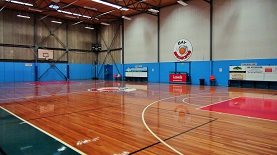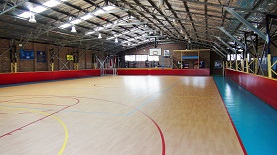Editorial: Is Eurobodalla ready for COVID-19 ? Are you ready?
- The Beagle

- Mar 28, 2020
- 7 min read
Is Eurobodalla ready for COVID-19 ? Are you ready? Some cold hard facts: Below is an image of Spain’s latest emergency overflow hospital in Madrid that has patients already arriving because the Madrid hospitals are full.

Eurobodalla doesn't have an auditorium that size. What we have is the Hanging Rock Basket Ball Court, the Moruya Basketball court and the Narooma Leisure centre and a few council halls.
Most of us became familiar with these facilities during the bushfires. Most of us have memories of the failures and inadequacies of these facilities.
Fortunately the worst we suffered was having Moruya and Narooma come down with gastro. In terms of Emergency Evacuation Centres that even begun to meet guidelines and standards ours FAILED. The fire events in early January 2020 saw up to nine and half thousand people register through the three evacuation centres including people evacuating from Bermagui. They were scared but they were NOT desperately ill or contagious.
In Council's submission to the NSW Bushfire Inquiry they write "It is important to remember that the arrangements in place are intended to keep people safe and to manage the expectations of the community in the difficult circumstances prevailing at that time. This was perhaps best summed up by the Manager of the Moruya Evacuation Centre when addressing the many hundreds of people at a briefing where it was highlighted that ‘this is a life boat situation – we are not on a cruise ship’."
If the Hanging Rock Sports Stadium, the Moruya Basketball court and the Narooma Leisure Centre are called into play to meet any Covid-19 victim overload then we will be faced with a "lifeboat" more like a sieve that provides little more than four walls and a roof.
Intensive care units: ABC reports Last winter, Australia suffered a vicious flu season that killed 812 Australians.
A bad flu season can land around 2,500 of us in ICU.
But if coronavirus infects 20 per cent of Australians as some state health departments are preparing for, about 100 times as many Australians will end up in intensive care.
Australia has just over 2,200 intensive care beds, with almost half of these in NSW.
That's around 8.9 ICU beds per 100,000 people, which is better than New Zealand (5.1 beds) but worse than Italy (12.5), where COVID-19 has overwhelmed hospitals.
COVID-19 patients in ICU will need a bed for around 10 days, according to Imperial College modelling, which is a lot longer than the average time for other causes (just under four days). And those beds can mean the difference between surviving the disease and dying from it.
Click here for full ABC report : Coronavirus could flood our hospital ICUs with COVID-19 patients, so do we have enough beds?
Below is an image of an Intensive care unit with systems and equipment that might save the life of the patients that need them. This unit has seven beds.
In the Eurobodalla we have ZERO ICU beds.

If any of our community are in need of an ICU bed they will need to be evacuated. By ambulance, by helicopter - if either are available. FACT: (SOURCE) The Moruya hospital – is a 55 bed hospital at level 3 role delineation. It offers the following services:
Emergency department
Inpatient acute medical care provided by General Practitioners
General and gynaecological surgery
Sub-acute - inpatient rehabilitation and palliative care
Maternity (antenatal care, birthing and post-natal care)
Hospital in The Home
An outreach renal dialysis satellite service as a formal network from Canberra
Pathology
X-ray, ultrasound and CT
Batemans Bay hospital is a 31 bed hospital at level 2 role delineation. It offers the following services:
Emergency department
Inpatient acute medical provided by General Practitioners
Day only surgery – cataract surgery, minor orthopaedics, minor urology and gastrointestinal endoscopy
Subacute – inpatient palliative care and patients waiting for rehabilitation
Pathology collection
X-ray If our two local hospitals can't meet the demand of beds and evacuations to other hospitals is not an option then we will have to consider alternate local locations such as halls. Just as they have done in China, Italy, Spain, the US, Serbia and Israel
Why is everybody going nuts about 'outsiders' escaping to the South Coast ?
Let's look at Spain as a current example. Marie Stacey blogs that Madrid has more than double confirmed cases than the next province. When Madrid was put on lockdown hundreds, maybe even thousands of people, decided to leave Madrid and head to their holiday homes on the Costas, which was a regrettable and uneducated decision.
Whilst all these people felt well at the time they left some have now already died since arriving while others unfortunately brought the virus on their travels with them.
Sadly it was witnessed that those who came did not go into self isolation but wandered freely, unaware they were infected. And those who should have been in imposed isolation flaunted the rules.
This virus would have spread regardless in these coastal communities but the process was unfortunately speeded up. On average an infected person can unknowingly infect 10 other people a day....these 10 people then infect 100 people....these 100 people infect 1000 people and so on. The first symptoms can show anywhere from 3 to 5 days becoming more severe a few days after that.

Morgues:
During the bushfires we had 40 of our community on hold, waiting to be buried or cremated.
Our cemetery plots were under ember attack as was our crematorium. We brought in temporary morgues until things returned to normal. Those were not unusually high numbers of deaths. We live an a region that has a much older median age and that is just how it is.
Self -Isolation
The NSW Police will begin to oversee IMPOSED Self Isolation requirements as of midnight tonight.
Anyone found NOT complying will face immediate on the spot fines.
The Southern NSW Local Health District reports that a total of 31 confirmed cases of COVID-19 have been identified within the District (from 7:20am 28 March, 2020)
This includes:
7 cases in the Bega Valley,
4 in the Eurobodalla
A Confirmed case is:
A person who tests positive to a validated specific SARS-CoV-2 nucleic acid test or has the virus identified by electron microscopy or viral culture, at a reference laboratory.
The case definitions are based on what is currently known about the clinical and epidemiological profile of cases of COVID-19 presenting to date both in Australia and internationally. Health authorities are constantly monitoring the spectrum of clinical symptoms as cases arise, and, if there are any significant shifts, they will be reflected in the above definitions in future versions of this document.
The 14 day period is based upon what is currently known to be the upper time limit of the incubation period. As more precise information about the incubation period emerges, this will be reviewed.
Close contact definition A close contact is defined as requiring:
greater than 15 minutes face-to-face contact in any setting with a confirmed case in the period extending from 24 hours before onset of symptoms in the confirmed case, or
sharing of a closed space with a confirmed case for a prolonged period (e.g. more than 2 hours) in the period extending from 24 hours before onset of symptoms in the confirmed case.
For the purposes of surveillance, a close contact includes a person meeting any of the following criteria:
Living in the same household or household-like setting (e.g. in a boarding school or hostel).
Direct contact with the body fluids or laboratory specimens of a case without recommended PPE or failure of PPE.
A person who spent 2 hours or longer in the same room (such as a GP or ED waiting room).
A person in the same hospital room when an aerosol generating procedure is undertaken on the case, without recommended PPE.
Aircraft passengers who were seated in the same row as the case, or in the two rows in front or two rows behind a confirmed COVID-19 case. Contact tracing of people who may have had close contact on long bus or train trips should also be attempted where possible, using similar seating/proximity criteria.
All crew-members on an aircraft who worked in the same cabin area as a confirmed case of COVID-19. If a crew member is the COVID-19case, contact tracing efforts should concentrate on passengers seated in the area where the crew member was working during the flight and all of the other members of the crew.
Casual contact definition
Casual contact is defined as any person having less than 15 minutes face-to-face contact with a symptomatic confirmed case in any setting, or sharing a closed space with a symptomatic confirmed case for less than 2 hours. This will include healthcare workers, other patients, or visitors who were in the same closed healthcare space as a case, but for shorter periods than those required for a close contact. Other closed settings might include schools or offices.
Note that healthcare workers and other contacts who have taken recommended infection control precautions, including the use of full PPE, while caring for a symptomatic confirmed COVID-19 case are not considered to be close contacts. However, these people should be advised to self-monitor and if they develop symptoms consistent with COVID-19 infection they should isolate themselves and notify their public health unit or staff health unit so they can be tested and managed as a suspected COVID-19 case.
Other casual contacts may include:
Extended family groups, e.g. in an Aboriginal community.
Aircraft passengers who were not seated nearby a symptomatic confirmed case or a crewmember who did not work in the same cabin area as a symptomatic confirmed case (see close contact definition).
Passengers and crew on-board the same cruise ship as a symptomatic confirmed case (or cases), who are not considered to be close contacts. See Special situations for further information.
Where resources permit, more active contact tracing may be extended to other persons who have had casual contact (as defined above), particularly in school, office, or other closed settings. In these circumstances, the size of the room/space and degree of separation of the case from others should be considered in identifying contacts.













